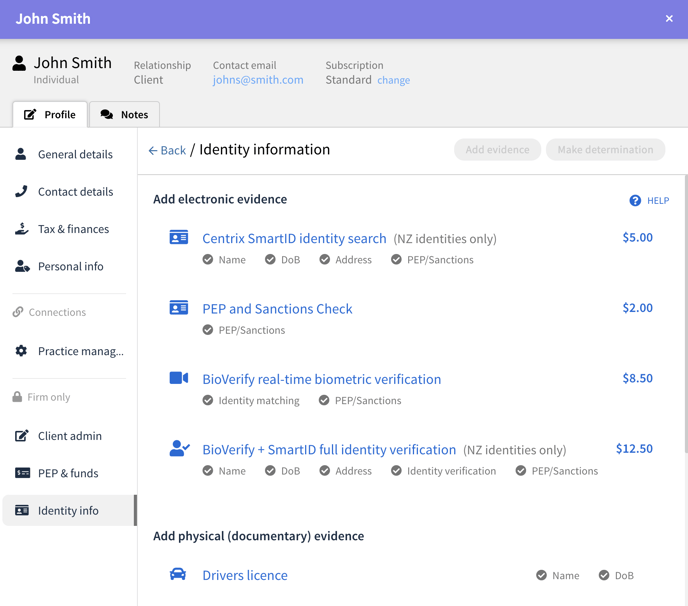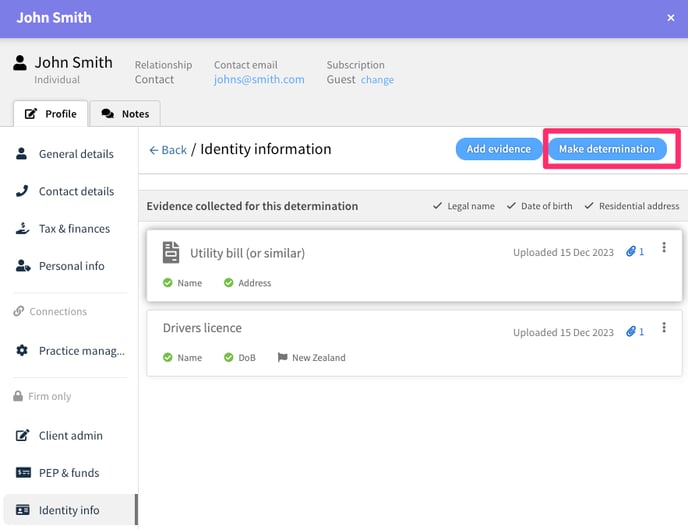Verifying Client Identities
How to verify client identities in Connectworks
The Anti-Money Laundering and Countering Financing of Terrorism Act (2009) requires many professional services providers (or 'reporting entities', including lawyers and accountants) to obtain and verify identity information on their clients, their beneficial owners, and anyone authorised to act on their client's behalf.
Connectworks provides a three-step process for identity verification:
-
Record identity information in a person's Connectworks profile
-
Gather evidence confirming the veracity of that information
-
Make a determination that the identity information belongs to the person claiming it
This article explains where and how to perform this client due diligence (CDD) process in Connectworks.
Contents
1. Recording Identity Information
3. Collecting Identity Evidence
4. Electronic Identity Verification in Connectworks
5. Matching Identity Evidence to Identity Information
6. Making an Identity Determination
7. Re-using Identity Determinations
Recording Identity Information
In most cases, the AML/CFT Act requires reporting entities to obtain the name, date of birth, and address of each person requiring CDD concerning a client. In Connectworks, this information is stored in the person's Contact Profile and accessed from the Firm's Contacts list via the edit profile function.
Types of Identity Evidence
Connectworks supports two ways of verifying the validity of identity information:
-
Via documentary evidence - Verification via documentary evidence requires you to view or obtain identity documents containing verified identity information. These identity documents can include a driver's licence, passport, or utility bill and can be obtained face-to-face or via certified copy.
-
Via electronic evidence - Verification via electronic evidence uses electronic records containing authenticated identity information as evidence that any obtained identity information that matches those records is legitimate. Electronic records must be independent and reliable, including government and retail databases.
Collecting Identity Evidence
Identity evidence is collected in the Identity Information section of the Contact Profile. Before collecting identity information for a contact, you should merge any duplicate contact profiles.

Electronic Identity Verification in Connectworks
Connectworks is integrated with Centrix SmartID, a third-party provider of electronic identity verification services.
Centrix compares the identity information you supply with records stored in independent and reliable electronic databases, including DIA and NZTA databases for passport and driver licence verifications; banks, finance, and utility company databases for proof of address, name and date of birth; and the full international Acuris PEP and sanctions databases.
To use Centrix SmartID services in Connectworks, please look at Centrix SmartID (Electronic Identity Verification).
Matching Identity Evidence to Identity Information
Each type of identity evidence matches two or more pieces of identity information. For example, a driver's licence matches the name and date of birth information, whereas a utility bill matches the name and address information. When identity evidence is recorded, Connectworks displays ticks against the pieces of identity information it relates to.
Making an Identity Determination
The final step in the identity verification process is to confirm that the identity has been verified.
Once all required identity evidence has been collected, you can select the 'Make Determination' action.

Re-using Identity Determinations
When a person's identity is determined to be verified, the determination record attaches to the person's Connectworks profile. When a person's profile is accessed via the AML / Client Due Diligence workflow, any existing identity determination records can be reused. You only have to go through the verification process once.
